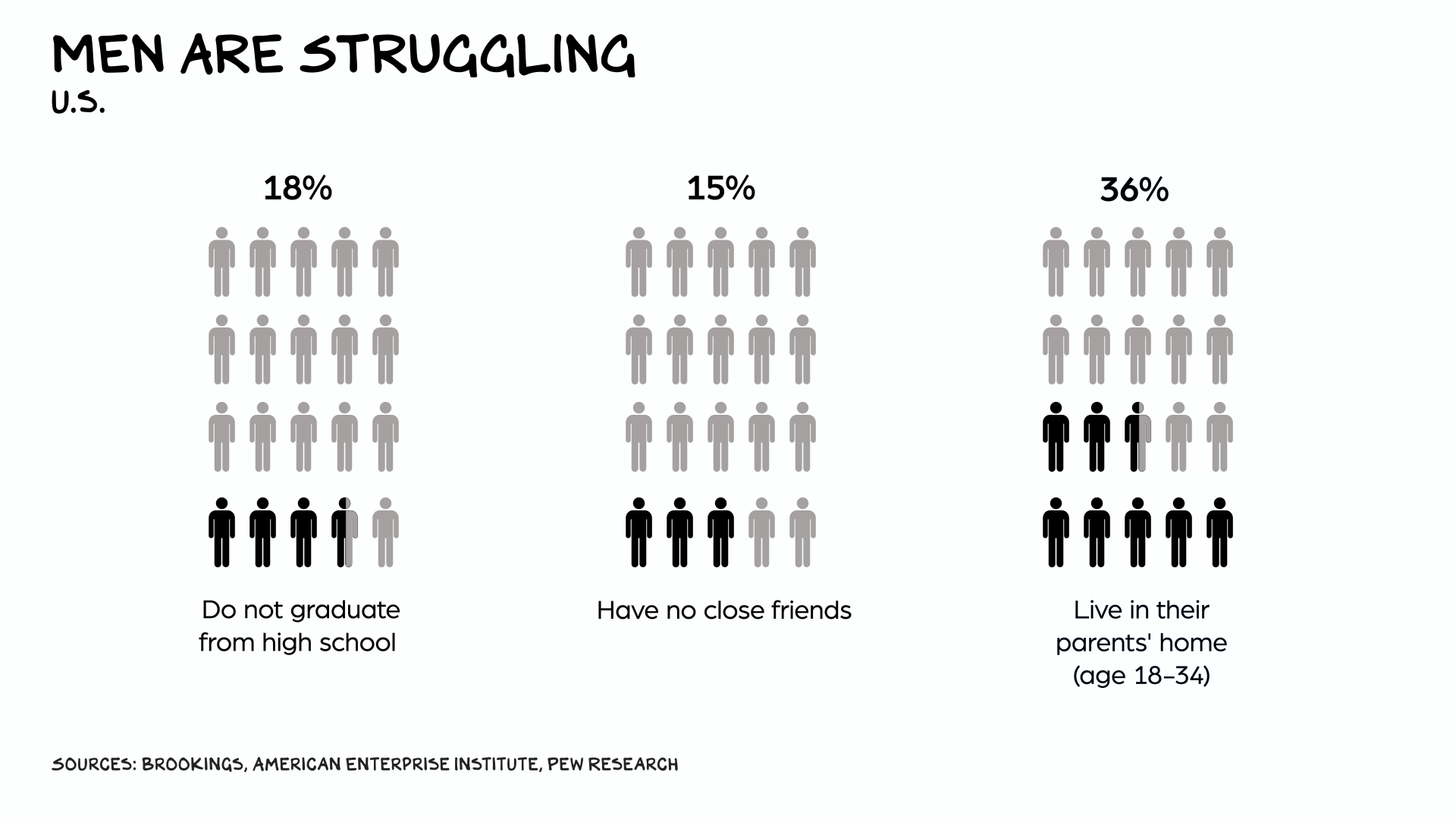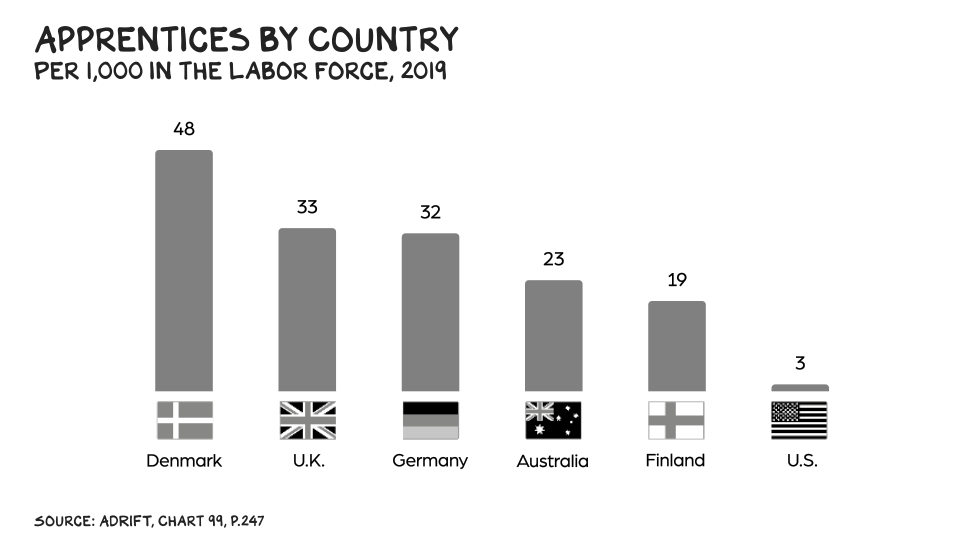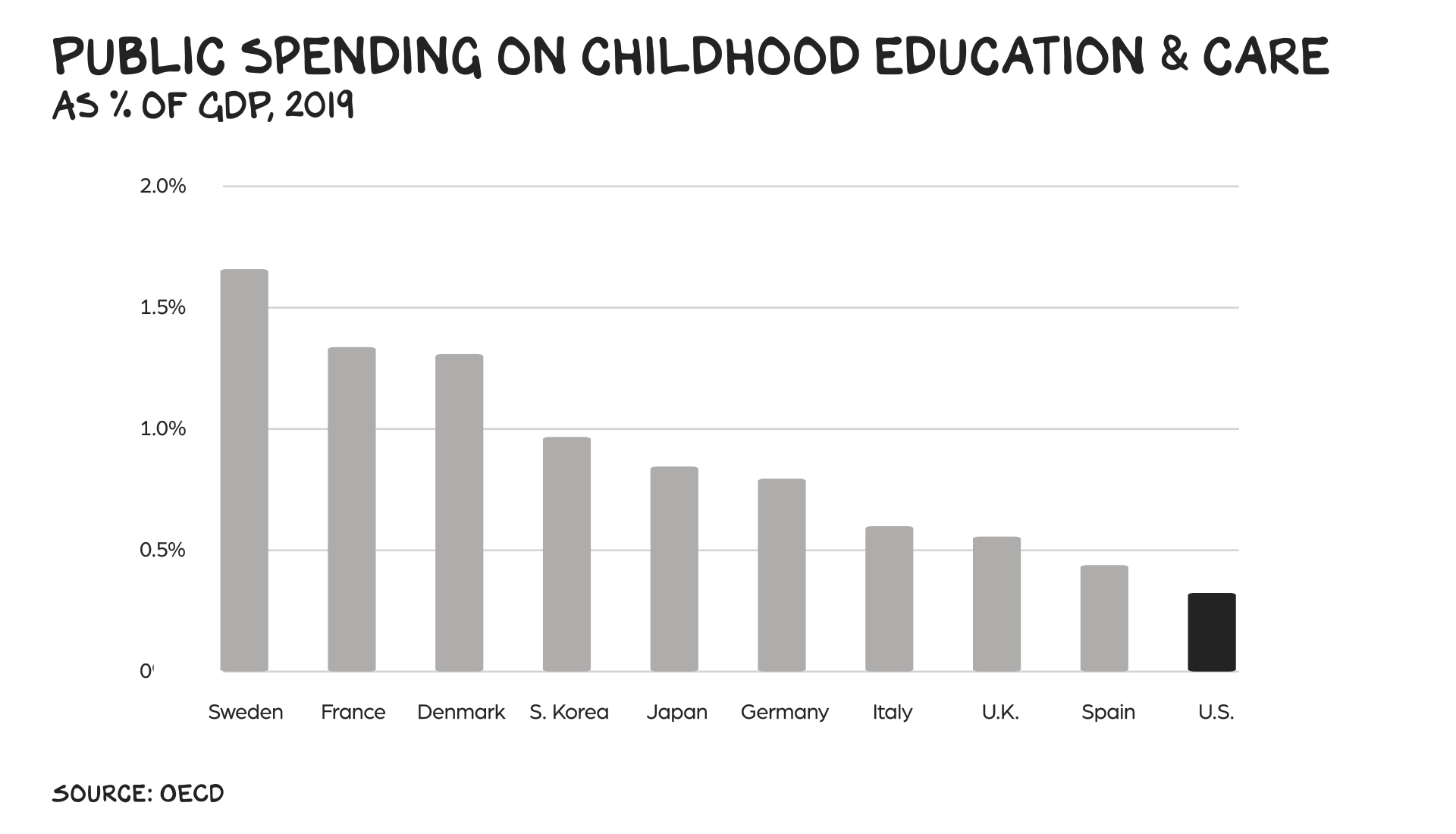Boys to Men
By Scott Galloway, No Mercy/No Malice, @profgalloway
-
Audio Recording by George Hahn
America has a vision of itself as the land of opportunity, with rights and liberty for everyone. That is not and has never been the reality. But for 250 years we’ve been closing that gap at a greater pace than any other multicultural democracy. Lately, however, there’s evidence we’re losing ground. Life expectancy is down, inequality is up, and our discourse has become increasingly coarse. Every segment of society, except the wealthiest, can point to setbacks. One group’s slide is particularly steep, and its decline presents a threat to the commonwealth and our prosperity: Our young men are failing, and we are failing them.
Crisis
Boys start school less prepared than girls, and they’re less likely to graduate from high school and attend or graduate from college. One in seven men reports having no friends, and three of every four deaths of despair in America — suicides and drug overdoses — are men. I’ve written about this at length here, and about how it relates to declining birth rates here.

Alienation and disaffection drive despair and violence. By age 27, high school dropouts are four times more likely to be arrested, fired by their employer, on government aid, or addicted to drugs than their peers who graduated. We face declining household formation, reduced birth rates, and slowing economic growth just as baby boomers enter decades of nonproductive retirement.
The lack of an open dialogue about these issues has created a void filled by voices espousing thinly veiled misogyny, demonization of vulnerable groups, and a vision for masculinity that wants to take non-whites and women back to the fifties and Old Spain, respectively. The good news is the dialogue has become much more productive recently. There’s a growing recognition of the size and severity of the challenges facing young men, and we can now turn our focus to solutions.
The Secret to Our Success
In 1945 the U.S. economy was the “Arsenal of Democracy,” a coast-to-coast assembly line of tanks, ships, and ammunition. Forty percent of the nation’s GDP went toward the war effort. (Today we spend 3% of our GDP on the military.) But at the end of World War II that economy lost its sole customer — and in short order, we had to find jobs for 10 million young people, mostly men, leaving military service and coming home. Wages fell, rents rose, workers in every major industry went on strike, and a nationalist movement began bubbling up. Leaders of every stripe feared a return of the Depression, or worse.
Except that’s not what happened. The next 30 years brought record-low unemployment, sustained economic growth, and world-changing technological innovation. Millions of households enjoyed steady increases in their quality of life, so much so that we had to invent a new social concept: the middle class. The term “working class” couldn’t encompass the two-car garage, summer vacations, and son (and soon, daughter) heading to college that exemplified an American middle-class lifestyle. And contrary to perception, the postwar middle class was not solely the province of white men. Twenty-seven million American women entered the workforce between 1950 and 1980, increasing their participation by 50%. The percent of Black men who were in the middle class by income rose from 22% in 1940 to 68% in 1970.
Underlying this prosperity was robust state support. The G.I. Bill funded college for 2 million soldiers and home loans and small business loans for hundreds of thousands more. Truman’s housing legislation expanded the government’s role in building homes and financing home ownership. Eisenhower launched a 40-year project to build a national highway system, at a cost of over $500 billion in today’s dollars. Income taxes were progressive — the top rate was 91% — and the wealth of the biggest earners was redistributed through social programs and investments in infrastructure, education, and science.
Redux
The greatest innovation in the history of the West, the American middle class, was the product of intentional and sustained public investment. Our retreat from that vision has led to decades of prosperity, but little progress. We’ve slid into a cascading pattern of failure — to rear, educate, and employ young men. Returning to our tradition of investment could rebuild the engine of capitalism and reverse the slide in their fortunes.
Some ideas:
Redshirt
The day a boy walks into school, he’s behind half the class. With brains that mature later than girls’, boys almost immediately fall behind girls in school. We should “redshirt” them, just as we hold back college athletes for a year so they can develop further. This proposal comes from Richard Reeves, who wrote last year’s landmark book Of Boys and Men. He joined me on my podcast and recently left Brookings to found the American Institute of Boys and Men.
Once in school, boys have fewer male role models. Fewer than 1 in 4 teachers in America are men, down from 1 in 3 in 1980. It’s a vicious cycle, as the fewer male teachers boys see, the less interested they become in pursuing teaching themselves. Lacking male exemplars of strength, kindness, and generosity, boys look elsewhere for models. Like Andrew Tate, the global “alpha male” sensation — and an accused trafficker, rapist and self-proclaimed pimp. New York’s NYC Men Teach initiative is a good start. It’s focused on men of color, however; we need more programs encouraging men — all men — to go back to school and serve as role models for our boys.
We need more extracurricular mentoring. One of the most influential people in my life was Cy Cordner, a stockbroker I met after walking into the Dean Witter Westwood office at age 13, who taught me about stocks and markets while in junior high. Cy, along with several other men who took an interest in me, helped shape the trajectory of my life and career. So do all mentors. Kids with mentors are 81% more likely to participate in sports, 78% more likely to volunteer in their community, and twice as likely to hold a leadership position at school. We need more male mentorship programs like Building Better Men, Growing Kings, and the Mentoring Alliance.
At UCLA I joined a fraternity my freshman year. Growing up without any siblings or a present father meant there were few men in my household. The Greek system has received a great deal of warranted scrutiny for encouraging reckless behavior. Yet I would, unreservedly, advocate for a young man/woman to join a fraternity/sorority. Zeta Beta Tau shrank an unfriendly place of 30,000 people down to a group of brothers who, in their own way, cared about one another.
Within a week of pledging, my “Big Brother” told me to stop smoking so much pot and reduce my class load from four to three to ensure I did well my first quarter and gain some confidence. Commonsense advice, which I lacked as a 17-year-old male who’d never spent more than seven days away from home. Without a network of other men serving as guardrails for me, I likely would not have graduated.
Young Men
Since the 1990s, preparing our kids for college has become entrenched in our DNA as the fundamental step to a brighter future for them. The rigid emphasis on national exams and $200,000 liberal arts degrees has crowded out vocational education as a path to success and stability. Parents shouldn’t worry about children who opt for woodworking vs. computer science. Instead we should worry about men who choose day trading and pornography over building, creating, and repairing. Vocational training in Germany is a pre-employment system for youth, imbuing skills in kids at a young age even if they decide to pursue college. Establishing a household without debt and a marketable skill is key to building a foundation for a family and relationships.

Some of our greatest citizens were apprentices, including Washington (surveyor), Franklin (printer), and Revere (silversmith). We need to sustain investment in this type of training, along the lines of Biden’s $150 million Apprenticeship Building Program.
Four-year colleges are still and will likely always be a tangible path to upward mobility. We should use the leverage we have over them as their primary financiers (i.e. tax payers) to break a corrupt higher-ed cartel and expand freshman seats. I wrote about this two weeks ago: Our fight over affirmative action and legacy admissions misses the forest for the trees. We need to add more seats, not a reallocation of elites across a zero-sum game kept static by universities that aspire to be Chanel bags vs. public servants.
Families
The vaccine to keep boys from becoming broke, lonely men is a stable childhood with male role models. Typically, that means two loving parents with reliable income and enough free time to spend with their kid. In 1960 roughly 5% of American children were born to unmarried mothers. Today that number is 40%. Between 1975 and 2020, the share of children living without one or both of their parents doubled — from 15% to 30%. Single parent environments can be loving and can produce productive citizens — I am the product of one of them. However, we shouldn’t pretend that every modern (or traditional) family is a harmonious and stable environment. Marriage isn’t the only way to build a family foundation, but it’s a potent one. Kids raised by married parents have stronger relationships with their fathers, see greater health and educational achievements, and are far less likely to experience physical/emotional/sexual abuse or poverty. Interestingly, girls are less affected by family instability and single parenthood than boys. Likely explanation: Boys are physically stronger and girls are emotionally and mentally stronger.

How to keep more parents from divorcing? A: Money. One-third of American couples say money is a major source of conflict in their relationship, and research shows financial disagreements are the strongest predictor of divorce. Economic stress is tearing at the fabric of young families today, as 35-year-old Americans have half as much wealth than they did in 1989. Meanwhile, 75-year-olds are twice as rich. We continue — via Nimbyist housing permit laws, rollbacks on child tax credits, preferential capital gains tax rates, and corporate tax loopholes — to transfer money and opportunity from young to old. Congress should continue the bipartisan effort to extend the child tax credit, which relieves some of the economic burden facing young parents.
Demographics Are Destiny
We don’t have to do any of this. But we’re barreling toward a nation of old people where over half of government spending will be on seniors, diminishing our ability to invest. As is happening in Japan and Italy, this results in an anemic economy that loses relevance on the global stage. The population decline across the West is the biggest threat to democracy. Today, 1 in 6 Americans is 65 or older — a century ago it was 1 in 20. We spend, as a percentage of GDP, 7% on seniors vs. 0.5% on children. The demographic situation is getting so dire that ratings agencies are predicting half of nations’ credit ratings will be downgraded to junk in the next 40 years. (We discussed this on Prof G Markets.)

The population “bomb” predicted in the seventies was half right: It has detonated, but it was an implosion. Democracy and capitalism need household formation, which means they need more economically and emotionally viable men to partner with women, who’ve registered exceptional, hard-fought gains. One of the primary reasons women terminate pregnancies is they feel they do not have a reliable partner.
Invest
Each year, $8 trillion worth of stocks and bonds trade hands. Of that $8 trillion, only $300 billion represents “true investment,” used to grow companies via IPOs or secondary issuances. And that’s a problem. We’ve become a nation of arbitrageurs vs. investors. We arbitrage information, distributing whatever creates the most engagement vs. pursuing the truth. We arbitrage fossil fuels and ignore the externalities. And worse yet, we arbitrage youth — milking them for capital and labor to enrich the incumbents. If there was ever a law that highlighted the war on youth, other than a minimum wage that’s below the poverty line, it’s this: student loan debt cannot be discharged in bankruptcy. A clean start, a second chance — these ideals are core to the American experience. However, our youth are sequestered from this American ideal. Think about this: The cohort not given a second chance is the generation that deserves it most, young people.
What is the point of all this? Our economy, education, laws, our society? I’d offer that the whole shooting match, the whole reason for a nation, is to create a context for deep and meaningful relationships. Deaths of despair, a lack of economic opportunity, and lost young men are all signs that our nation continues to offer prosperity but not progress. It’s time again to start investing. America needs young men, and they need us.
Life is so rich,
![]()
P.S. This week on the Prof G Pod, I spoke with Jake Tapper, CNN’s chief Washington correspondent. We discussed his latest book, “All The Demons Are Here,” and the upcoming presidential election. Listen here.
P.P.S. Last call to join my free event next week: The Threats and Opportunities of AI with me and Gary Marcus. Sign up here.



